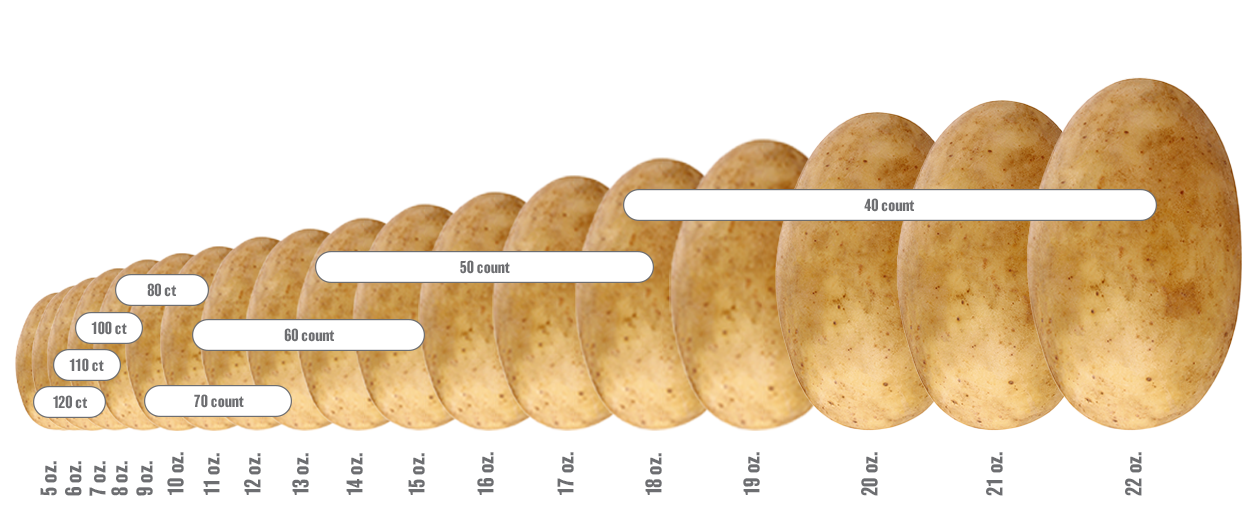Potatoes
Potatoes may seem like they are basically all the same, but the different varieties have subtle differences that make them more ideal for particular applications. Learn about the different types of potatoes and which ones are best for your dishes.
Find everything you need to know to make the right potato purchasing decisions. See information on potato varieties and sizing, potato grades and potato storage and handling.
Find everything you need to know to make the right potato purchasing decisions. See information on potato varieties and sizing, potato grades and potato storage and handling.
Page contents:
Popular Potato Varieties | Sizing and Application | Potato Grades | Storage and Handling
Popular Potato Varieties
| Variety | Primary Applications and Attributes | |
|---|---|---|
| Russet (Burbank) |
Typically, harvest begins in September. Superior performance when deep fried. Best for frying and considered the #1 french fry potato. High solids, very versatile for many applications. | 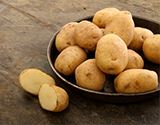 |
| Russet (Norkotah) |
Typically, harvest begins in August. Generally yield more No. 1's, so they are better-looking potatoes. Recommended when serving whole potatoes. May require different frying techniques than the Burbank. | 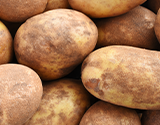 |
| Round Potatoes (aka Chef Potatoes) |
Similar to a russet with a medium level of starch, white potatoes have a smoother, thinner and lighter skin. The term 'Chef Potato' was adoped to the product due to its large size profile and versatility. Extremely versatile and can be used for baking, boiling, frying, mashing, roasting or steaming. Makes a fantastic skin on mashed potato by simply adding butter, cream,and salt and pepper. | 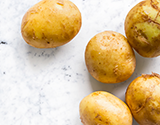 |
| Red | Small to medium sized and are round or oval shaped. The skin is smooth and ruby to deep red in color. The flesh is crisp, white, and firm. When cooked, it has a buttery mild earthy flavor. While red potatoes can be roasted or baked they are mostly known to be a fantastic potato for boiling applications because they absorb water well, while maintaining their shape. The skin is tender so any cooking application with skin on is preferable. Red potatoes are best for soups and stews or low country boils, mashed, cold potato salads or roasted as breakfast items. | 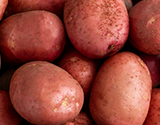 |
| Yellow/Yukon Gold | Yukon Gold potatoes are medium to large in size and are round to oblong, with a slightly flattened shape. The flesh is yellow to gold, firm, moist and waxy. When cooked, they take on a creamy and tender consistency with a rich buttery and earthy flavor. While this potato is incredibly versatile due to its medium starch content and sweet taste, it is best utilized boiled or roasted. Can be use in au gratins, simmered into soups and stews, sautéed into breakfast dishes or mashed with cream and butter. |  |
| Sweet | The sweet potato is a starchy, sweet-tasting root vegetable that originated in tropical America. The yam is a starchy, edible root that orginated in West Africa and Asia. The terms 'Sweet Potatoes' and 'Yams' are used interchangeably in the U.S. Today, the U.S. Dept. of Agriculture requires labels with the term 'yam' to be accoumpanied by the term 'sweet potato'. Can be stewed, baked and topped with savory or sweet items alike, mashed with butter and cream, and roasted with fresh herbs and garlic or sliced thin and fried into chips. Smaller potatoes can be roasted with the skin on, while larger potatoes tend to have tough skins that must be peeled before preparing. | 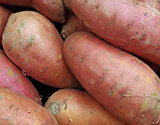 |
SIZING and Application
| Popular Varieties | Sizing | |||||||||||||||||||||||||||
|---|---|---|---|---|---|---|---|---|---|---|---|---|---|---|---|---|---|---|---|---|---|---|---|---|---|---|---|---|
| Russet Potato Sizing (Burbank & Norkotah) |
|
|||||||||||||||||||||||||||
| Round White AKA Chef Potatoes | A is usually cut up and further processed. B is the most common in foodservice. B and C are usually served whole; these are more expensive per pound than A's, but the serving cost per plate is less. 90 ct. is sold primarily in North Dakota. Jumbo or premium sizes are generally used for applications that require peeling. The larger-sized potato means less potatoes to peel and better yield. | |||||||||||||||||||||||||||
| Red | A: 2"-3.5" B: 1.5"-2.25" (Most Common in foodservice) C: .75"- 15/8" "Thumb": fingerling | |||||||||||||||||||||||||||
| Yellow/Yukon Gold | Size A: 2"-3.5" | |||||||||||||||||||||||||||
| Sweet | Grades: U.S. Extra No.1 & U.S. No. 1. Also can be found as a fingerling size | |||||||||||||||||||||||||||
Potato Grades
Prior to packing and shipping, potatoes are graded and, where appropriate, sized.
U.S. No. 1 Potatoes must meet the following requirements:
- Similar varietal characteristics, except when designated as a mixed or specialty pack
- Firm, fairly clean, fairly well-shaped
- Free from freezing, blackheart, late blight, southern bacterial wilt and ring rot; and soft rot and wet breakdown
- Free from damage by any other cause
- Size not less than 1-7/8 inches in diameter, unless otherwise specified in connection with the grade
U.S. No. 2 Potatoes must meet the following requirements:
- Similar varietal characteristics, except when designated as a mixed or specialty pack
- Not seriously misshapen
- Free from freezing, blackheart, late blight, Southern bacterial wilt and ring rot; and soft rot and wet breakdown
- Free from serious damage by any other cause
- Size not less than 1-1/2 inches in diameter, unless otherwise specified in connection with the grade
Source: U.S. Department of Agriculture
COMMODITY POTATOES – STORAGE AND HANDLING
Proper storage and handling of potatoes is just as important as the quality of the pack so that the product can behave as it should. The following tips are recommended about how to best handle and store potatoes.
- Store potatoes in a cool, dark and well-ventilated place. Darker storage areas will help prolong shelf life and avoid greening, which can cause bitter taste
- They will keep about a week at room temperature and for several weeks at 45-50°F
- Below 45°F, potato starch will turn to sugar. This process can be reversed by storing potatoes at 55-60°F for up to 14 days


